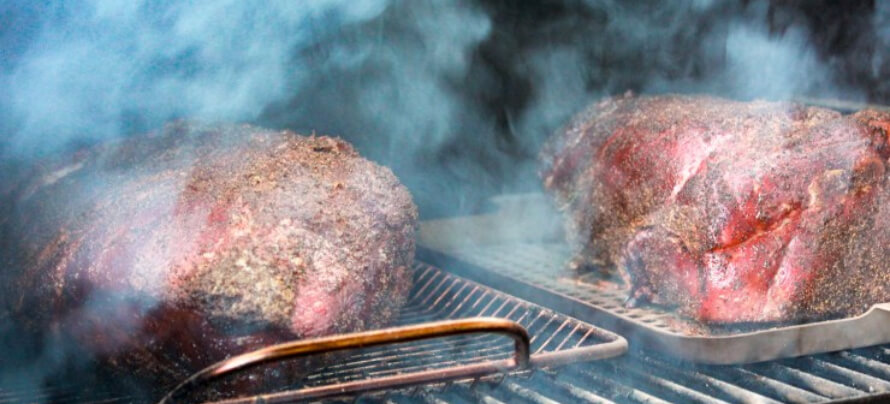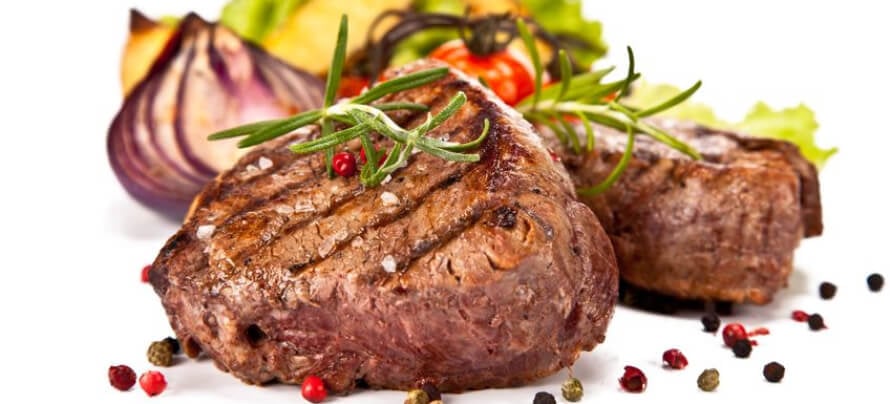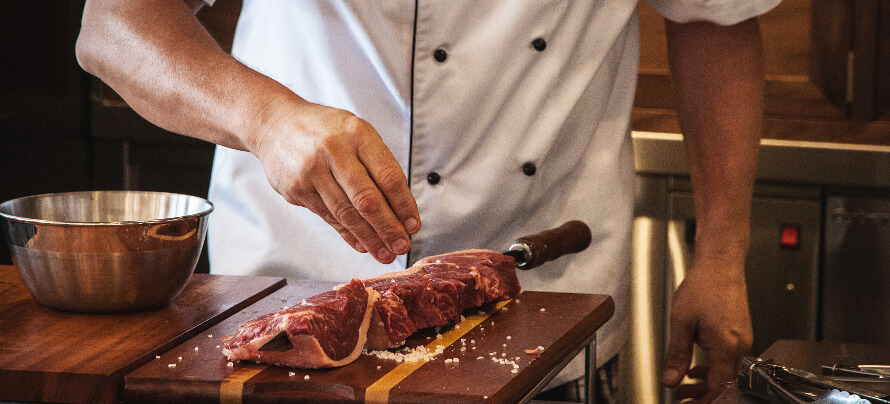Key Takeaways
- Meat contains, either inherently or from cooking, various compounds associated with cancer formation. In particular, colon cancer.
- The most common meat toxins are found in low-quality preserved meats or are created by burning or overly smoking any kind of meat.
- The best ways to avoid meat toxins are to eat mostly chicken and fish instead of red or pink meats, cook meat in moist or smoke-free ways, and to eat meat with vegetables like broccoli.
There are a few things you need to get right about your diet if you want to build muscle.
You need to eat protein—a lot of protein—and you can’t just completely overdose on protein powders. You need some real food, too.
It’s the most basic tenet of eating to build muscle. Get food, get protein, get lots of both.
Naturally, that leads many bodybuilders and weightlifters to eat a lot of meat.
Vegan bodybuilding is possible but not for everybody.
Meat and building muscle go together like beer and fishing—the former just makes the latter so much more tolerable, enjoyable, and effective.
So what happens if I were to tell you meat is giving you cancer?
And that wasn’t a joke?
Extreme hyperbole, yes, but technically speaking meat does contain various carcinogens in it. In addition, the process of cooking meat can create other byproducts that also increase the risk of cancer.
That’s more or less unavoidable, too, because it happens any time meat is heated (whether it’s on a barbeque or in the oven).
If we’re looking for long-term health then these byproducts may not be the best for us. Specifically, our poopers. Excessive meat consumption, poor cooking techniques, and inadequate veggies is most definitely a risk factor for colon cancer.
Don’t despair, though.
There are ways to prepare your meat so that production of these molecules is quite limited.
Proper cooking of meat, careful selection of what meats you do eat, and a focus on eating plenty of plants can all work together to ensure that the “potential” for meat to contribute to cancer doesn’t turn into a “reality.”
Before we get into how to cook your meat, let’s first look at what toxins are found in meat.
What are Meat Toxins?
“Meat toxins” is a term used to refer to various compounds, found in meat, that at times have been associated with toxic or cancer-promoting (carcinogenic) effects.
Whether they naturally occur in meat, were added into the meat at some point in manufacturing, or are created during the cooking and preparation stages of meat, they will all eventually find their way into our mouths and bodies.
I’ll be honest here—meat does cause cancer.
Everything causes cancer, but meat seems to do so to a degree where I can’t easily brush it off as inert. More technically, since that was a statement pedants’ mouths are watering over, I am convinced by the epidemiological evidence that there is indeed a correlation between meat and colorectal cancer.
You’ll find that while topics of breast cancer, liver cancer, and such are up in the air when it comes to meat, colorectal cancers have pretty damn solid evidence. Putting our heads in the ground like a politically radical ostrich exposed to emu propaganda won’t do anybody good.
Of course it’s not a big enough concern for me to get my panties in a bunch and go pescatarian (cause fish is seemingly innocuous) since, sometimes, the association just isn’t there. It’s a risk that’s heavily influenced by lifestyle factors and, in other words, can be controlled.
It is, in my opinion, a big enough concern for me to think of harm mitigation or at least thinking of how to control it. Why accept the increased risk when you can simply not?
We could just not eat meat but there are two problems with this—first is that if you get into the mindset of avoiding all toxins you’re going to end up starving to death hiding in a bubble, and second is that it’s boring (at least in my opinion).
Meat’s great, let’s just make it not harm us as much (if at all).
There are four groups of molecules that I’ll be covering on this topic. Understand, however, that they are groups of molecules rather than individual molecules—would be too tedious to break down each and every one of them.
- Polyaromatic hydrocarbons (PAHs), the smoke-related carcinogens
- Heterocyclic amines (HCAs), the dry heat carcinogens
- Advanced glycation end products (AGEs), the inevitable oxidants
- Nitrosamines (NAs), the preservative carcinogens
And at the end of the article, you’ll know how to cook meat in both healthy and unhealthy ways. Hopefully you’ll opt for the former.
Recommended Reading:
Polyaromatic Hydrocarbons

Polyaromatic hydrocarbons (PAHs henceforth) are a large group of molecules associated with smoke.
As a general rule of thumb, when there’s smoke there’s fire and they bring about PAHs. This class of molecules is involved in everything from car exhaust, to cigarette smoking, to pretty much any major urbanization process due to fumes being produced.
When it comes to cooking, however, we’re mostly concerned with the process of “smoking” a meat. Either done properly, which results in a nice Montreal smoked meat, or improperly like when you keep the hood down on your barbeque and turn your steaks into charcoal.
Truth be told, you don’t need to worry about PAHs that much unless your barbeque sessions look like you’re trying to commune with Satan, causing your neighbours to bring a sacrificial lamb “just to be sure.”
Among the “toxins” listed in this article PAHs are the most easily avoidable for two reasons—you could simply cook your meat in a manner in which smoke is not formed in large amounts, and the fact that PAHs require “bioactivation” before becoming a concern.
What Is Bioactivation?
Bioactivation refers to a set of enzymes in our bodies, mostly the liver and intestines, collectively referred to as P450.
Divided between phase I and phase II, P450 is a group of enzymes tasked with identifying “foreign” or “alien” molecular structures, things that should not normally exist in the body, and rendering them inert before packaging them up for elimination.
This multipurpose workhorse of an enzyme system saves our bodies from a lot of dangers but it isn’t perfect. Sometimes it prevents otherwise beneficial compounds from getting absorbed (which occurs with curcumin) and at other times it accidentally activates an otherwise inert compound.
Whoops.
PAHs, inherently, are stable molecules. If they get into our bodies and nothing happens to them, they simply leave the body without doing much. Unfortunately, when our P450 system attempts to “neutralize” the threat they instead cause it to become a threat.
It’s notable enough that the differing levels of these enzymes from one person to the next somewhat predicts their cancer risk. For PAHs the specific P450 enzyme in question seems to be CYP1A1/CYP1A2—you might know this guy better by the name “aromatase” that comes up in discussions on testosterone and estrogen every now and then.
Both of these enzymes follow a similar motif—the faster the enzyme works the more at risk you are. One study in particular, which looked at smokers (smoking makes CYP1A2 work faster) consuming well-done red meat noted an 8.8-fold increase in colorectal cancer risk.
So if you’re going to be exposed to PAHs then it’s best to calm these enzymes down a bit.
What Can I Do About PAHs?
On the whole, PAHs are easily avoided.
If you don’t smoke, then your PHA intake should be fairly small, which is good because there aren’t that many supplements you can take to deal with them once they’re inside you.
There are many supplements and foods out there with “anti-cancer” properties but a common unifying thread is that they’re mild and preventative (rather than rehabilitative). Sure, in theory, we can hinder the activity of aromatase to mitigate bioactivation but there’s just one kinda major issue.
If there was a potent over-the-counter aromatase inhibitor it would be present in every single testosterone booster in existence.
Why? Cause inhibiting this enzyme increases testosterone while reducing estrogen.
Aromatase inhibiting options that we have, like chrysin, tend to be weak and poorly absorbed. They can still play a role, since P450 exists in the gut as well (and you don’t need absorption for that region) but there are no studies using supplemental aromatase inhibitors for this purpose right now.
The best advice I can give is to have an otherwise healthy diet and limit smoked meats.
Recommended Reading:
Heterocyclic Amines

Heterocyclic amines (HCAs henceforth) are a byproduct formed by the combination of amino acids and sugars under high heat.
They are somewhat of an inevitability when cooking meat, given how it’s impossible to remove the amino acids and other amino acid structures (like creatine) from meat, and sugars are omnipresent in all meat sources (even if not listed on the label.)
However, unlike PAHs where they can be pretty easily avoided HCAs are:
- Omnipresent in all cooking techniques
- Highly dependent on how you cook the meat product
- Quite easily controlled, being either a problem or a non-issue
If you are to take anything away from this article it would be this section. HCAs seem to be the most modifiable and most easily controlled meat “toxin.”
What Can I Do About HCAs?
The first thing would be to cook your meat the right length of time.
When it comes to cooking meat you begin an inevitable process by which the heat will cause HCAs to form.
Cooking red meat to medium-rare is likely ideal, as cooking the meat from medium rare to well done increases the HCA content 3.5-fold. In all cuts of meat we see this trend, more time equals more HCAs.
Second are the temperature and dryness.
HCAs tend to be optimally formed in a moderate range of 100 to 250°C, which is fairly unavoidable when cooking meat, but this is significantly augmented by dryness.
If HCA formation is a combination of heat and time, then dryness is a 1.2x modifier.
Many studies compare pan-fried versus broiled for this reason. Broiling a piece of meat tends to keep the meat’s moisture inside the meat rather than having it leak out into the pan, which preserves the moisture and makes it a better option if no external fluids are added.
Furthermore, we can take another preventative measure here by marinating meat.
Marinades have been shown to play a major preventative role as long as they contain oils and antioxidants—maybe even red wine. By adding moisture, and with antioxidants hindering HCA formation, spice and oil marinades can reduce HCA formation during cooking.
The only exception is marinades with a lot of sugars (and oddly, soy sauce?), which increase HCA formation.
Finally, just as a heads up—HCAs are formed on the outside of the meat products. That means that when a meat leaves residue in the pan (the “fond”), and you want to deglaze it to make a sauce, there could be an appreciable HCA content in there—about as much as the meat itself if not higher.
To reduce HCA formation to acceptable levels, keep your meat moist and perhaps opt for a marinade containing antioxidant spices (i.e. almost all of them) and an oil rub.
Recommended Reading:
Advanced Glycation End Products
Advanced glycation end products (AGEs henceforth) are compounds formed during the browning process of meats when amino acids and/or lipids become exposed to sugars.
AGEs aren’t really a “meat toxin” specifically.
They’re formed endogenously within our own bodies regardless of our desires, can form from many food products, and are generally quite omnipresent. If amino acids, lipids, and sugar coexists then AGEs can form and, well, that’s every damn living cell in existence.
So it isn’t a question of perfect avoidance—that’s impossible—it’s a question of trying to limit unnecessary intake of AGEs.
And high fat foods that come packaged with a large amount of amino acids, like meat, are a major source of AGEs. Somewhat inherently as well, with red meats like beef having more than fish products although some AGEs do appear to be made when heat is applied as well.
However, unlike the HCAs which can increase to large degrees during cooking, the AGEs do not see too marked a rise during the cooking process compared to default levels.
So it seems like the cooking process is, honestly, not too major a concern here.
What Can I Do About AGEs?
When it comes to AGEs, it seems that choosing to eat meat is a more pivotal factor than how you cook your meat.
The “safest” meat would be sushi, since it’s fish (low in AGEs compared to land meat) that isn’t exposed to heat.
However, given how AGEs are created in our bodies and we’re concerned with their proposed effects on aging and oxidation it may be best to take more “rehabilitative” measures against them— ie. supplementation with antioxidants and such.
Ultimately, however, it’s the least concerning “toxin” in this list when it comes to cooking meat.
When it comes to enjoying meat, AGEs aren’t something worth worrying about. However, AGEs in general pop up every now and then on discussions for health so supplements that reduce their levels can help— even if you’re vegan.
Recommended Reading:
Nitrosamines

Nitrosamines (NAs henceforth) are known for being the “pink meat” preservative.
NAs are molecules that combine nitrate, a small molecule that serves vital health roles as a reservoir for the blood flow regulating nitric oxide, and amino acids. When the two bind together a nitrosamine forms.
There are many nitrosamines out there, and they’re used in various industries beyond food. When it comes to food they have the role of a preservative and, in particular, whenever you hear about something pertaining to “processed” meat or “pink” meat (preserved pork) it’s almost always a nitrosamine issue.
Once again, nitrosamines are technically unavoidable. Nitrates are in every vegetable out there, amino acids are in every food out there, nitrosamines can be formed in the intestines—you get the picture.
But like AGEs, just because something is technically unavoidable doesn’t mean we can’t mitigate intake somewhat. If we do have to eat NAs anyways then we can also attempt to mitigate their harm.
So, how do we go about doing that?
What Can I Do About NAs?
The best choice here is to not shove excess NAs into your face. Opt for fresher meat products rather than cheap bulk pork chops or dried deli meats.
I specify pork chops and deli meats since I at least acknowledge them as meat products. The process that turned the once honorable beef jerky into the debauchery that is Slim Jims are more of a concern for health, however.
Of course that’s a totally bourgeoise thing to say, just eat premium beef everyday like an elite as if money isn’t a concern, but if you can’t opt for discount chicken at the minimum then there may be some hope.
Vegetables.
Nitrosamines, and their sources, are routinely correlated with colorectal cancer (and every now and then have weak correlations with other forms of cancer) and these studies tend to find that diets high in vegetable intake exert protective effects. Nitrosamines increase risk, veggies decrease risk—perfectly balanced, as all things should be.
So at the very least, don’t let that pork chop fester alone in your colon without some fiber and antioxidants co-mingling with it.
The increased risk of colorectal cancer seen with pink meats and nitrosamines occurs alongside a decreased risk seen with higher vegetable intake. If you can’t avoid pink meats, but want to mitigate cancer risk, then ensure a high vegetable intake.
Recommended Reading:
What Is the Worst Way to Prepare Meat?
Now that we’ve outlined the four sections we can deduce what’s effectively the worst type of meat to consume.
First, sourcing.
It would probably be some cheap pork or beef product. Pork products tend to be much higher in the nitrosamines but beef tends to have higher AGE content. Regardless, cheap is key here since it’s chock full of preservatives.
This excludes just eating $5 worth of Costco “Smoked Meat-like Big Boy sticks” that look like beef jerky yet taste like canola oil and gluttony.
Second, cooking.
Now take that bad boy straight from frozen and throw it on the barbeque. Straight from frozen doesn’t play a major role in meat toxins but it’s positively barbaric and works well.
Put the hood down and keep it down until the sucker is cooked well done. I don’t want no “medium rare steaks,” I want a hunk of bovine or swine burned so bad that the crying Native American from those 70s littering PSAs comes back with a vengeance.
Disgrace the ancestors, burn the buffalo and smoke its remains.
Finally, eating.
Voraciously inhale it with a bun, no vegetables. Also, have a beer and a ciggie alongside the meat just to throw more problems onto your plate. Go back for seconds, and thirds, cancer cells can get lonely without friends after all.
A common tactic here is to have fries with your burger. This is a mistake. Fries are made from potatoes and potatoes are a vegetable. Furthermore, they provide some bulk to the intestines and mildly improve digestibility. This is a worst case scenario, siphon that meat.
The closest parallel situation I can think of is if somebody is hosting a barbeque for July 4th and buys hamburgers wholesale. They are then too preoccupied drinking with their friends to not infuse their burgers with smoke to the point where Beijing traffic would blush.
A few times a year is fine but don’t do that regularly. Furthermore, the next time somebody brings a platter of raw vegetables with dip to your barbeque, you thank them for their foresight in harm-reduction.
What Is the Best Way to Prepare Meat?

The best way to prepare meat is in stark contrast to the above.
First, sourcing.
I’m not going to be a prude and say to not eat red meats but, let’s be honest, red meat is in and out of the media frequently as to whether or not it harms you. Chicken and fish almost never are and, when they are, the articles are usually thoroughly mocked.
Opt for chicken and fish if you can, but we’ll proceed with the notion that you’re gonna cook pork and beef anyways.
You want meat, ideally, buy it from the butcher. Stuff that’s fresh and not full of preservatives. If you’re going to buy cheap then I would advise buying chicken cheap and maybe beef. Avoid overly processed “pink” meats that are on discount to limit nitrosamine intake.
Second, cooking.
Try your hand at marinades. A little bit of oil, some spices, give that bad boy a rub and let it rest in the fridge for a while.
A good herb to opt for is oregano since, not only does it taste great with red meats, but it has various preservative and antimicrobial properties when used as marinade.
When you are ready to cook it remember to always have ample moisture and to cook it relatively slow. Not abnormally slow, but just make sure you don’t fall into the scenario where you sear the outside and then keep the heat at the same level until it’s cooked to your liking.
Either sear first, and reduce the temperature for the rest of the cooking, or keep a stable temperature so browning occurs just as it’s about to be ready to be eaten.
Cook the meat with an open lid so smoke doesn’t accumulate in the pan or on the barbeque. If you’re barbecuing it and the meat cannot “rest” in oils then remember to frequently use rubs to keep the meat moist.
Finally, eating.
I’m going to come out of the gates and say to not consume meat with alcohol. Alcohol has a notoriously bad property of making any co-ingested harm worse—in instances where we cannot avoid all harm then, at the very least, don’t compound it.
Smoking is also bad to have with meat. Smoking is just bad in general.
If you’re micromanaging your meat intake to avoid cancer but you’re still smoking then you’re missing the forest for the trees—and you’re also an idiot.
Consume the meat with ample vegetables, both fiber and general bulk, and whatever else is to your liking. While consuming cruciferous vegetables like broccoli may be “best” it isn’t a topic to be too prudish about, even a corn hash with some coleslaw would be fine (coleslaw is actually amazing if the added fats are kept in check.)
Then finish with some water.
Marination, moist cooking, and veggies save the day.
The Bottom Line on Grilling Meat
It’s always better to have options with your choices, rather than just forgoing the choice entirely.
Hopefully with this knowledge you can take active measures in making your meat as healthy as it can be, or don’t if smoked charcoal is your comfort food—that’s your prerogative.
But it’s nice to know where in life we can even take harm reduction measures, and have them actually be feasible.
Also remember that when we talk about cancer risk and meats that colon cancer is severely overrepresented, as in that is the type of cancer most likely to be linked to meat consumption.
Colon cancer is also the cancer most protected against by good dietary habits so if you’re not changing your meat consuming habits then at least have veggies in your belly at the same time as the meat—over the long term always opt for a side of veggies with your red meat.
Like most things I write, your pooper will thank you in the long run.










